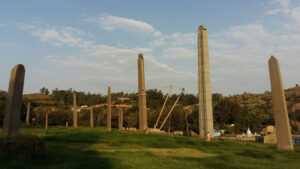Dating from around 300-500 AD, most of the Axum stelae seem to predate the arrival of Christianity to Ethiopia. Their purpose is almost certainly religious, but the details are not known for certain.
The stelae were most likely funeral monuments for Axum’s ancient rulers, who may have been buried in tombs beneath them. Some have altars at the base with grooves cut into them to carry away blood from sacrifices.
Christianity was adopted by the royal family in Axum in the 4th century AD, and by the population at large in the 5th century, which means these stelae date from a fascinating period of religious change. Monolithic monuments continued to be erected after the arrival of Christianity, and several with Christian inscriptions can be found.
The second largest of the stelae was looted by Mussolini’s troops in 1937 during his occupation of Ethiopia, and stood for decades in the Piazza di Porta Capenamin in Rome, near the Arch of Constantine.
The 160-ton monument was finally returned from Italy to Axum in April 2005. It was shipped in an extra-large plane in three separate pieces, at the cost of €6 million (almost $8 million). The transportation company that carried out the task said it was the largest and heaviest structure ever transported by air.
What to See at Axum Stelae Field
The Northern Stelae Field contains more than 120 stelae made of smooth, grey stone. The stelae are each made of a single piece of granite and stand as high as 82 feet. All the Axum stelae face south, and so watch the sun on its daily journey across the sky.
The Axum stelae are made to look like buildings and are intricately carved with windows, rows of log-ends dividing each story, and a false door at the base. These motifs on the face are carried through on the short sides of the obelisks. The “windows” also form cross shapes; perhaps a coincidence, perhaps not.
The back of each obelisk, however, is completely plain except for one circle carved near the apex. At its center is four spheres grouped together, with a fifth sphere touching the group’s outer edge.
The apex of each stele is carved into a semi-circular shape, which symbolizes the heavens. Scholars believe a metal plate with an image of the sun engraved inside a crescent moon was affixed to the front of these top semi-circles.
It may be that the stelae related to the worship of the sun god or that ancient worshippers hoped to draw energy down from the sky through these giant monuments. The image is similar to the Egyptian hieroglyph for sunrise, a semi-circle placed over the bottom corners of a triangle.
Another tradition, popular with the locals, is that the stelae are phallic symbols and relate to fertility.
The largest obelisk (108 feet long) has fallen and lies shattered across the ground, allowing a close-up inspection of the carvings. If it were still standing, it would be the tallest obelisk in the world. It may have fallen as soon as it was erected, representing the visible results of a trial-and-error in creating giant upright stele. According to legend, it covers the grave of the Queen of Sheba.
The tallest upright obelisk is the one recently returned from Rome (see above), which stands 82 feet in height.
The now-second tallest is the Stele of King Ezana, which stands at the entrance to the field. Ezana was the first king to convert to Christianity (c.300 AD), and he declared his entire country for Christianity after his conversion. A carving on his stele may refer to this event.
Another fallen Axum stele, almost 9m long, bears an especially interesting relief carving. Near its apex is a capital formed of two leaves supporting a square within a square surmounted by a triangle. This could be the earliest-ever image of the Ark of the Covenant in Ethiopian art.

